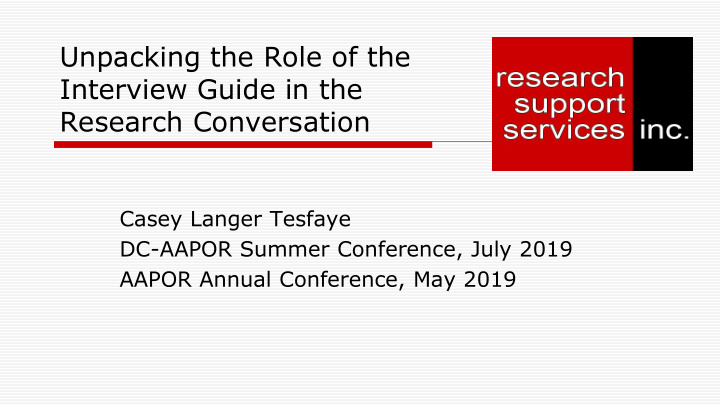



Unpacking the Role of the Interview Guide in the Research Conversation Casey Langer Tesfaye DC-AAPOR Summer Conference, July 2019 AAPOR Annual Conference, May 2019
First, let’s set the scene: Welcome.
First, let’s set the scene: First let me explain what an In-Depth- Interview is
A Research Interview is not Like a Normal Conversation It’s a conversation with a purpose.
A Research Interview is not Like a Normal Conversation We are alone, but our interview will be transcribed and read by others.
A Research Interview is not Like a Normal Conversation. I am here I am here to ask to answer questions. questions.
A Research Interview is not Like a Normal Conversation Some of these questions are very personal.
A Research Interview is not Like a Normal Conversation. I do this I have no for a living. idea what to expect.
Not only that… I’m following a script. This isn’t how I normally talk .
Two very different frames: Personal Conversation Research Conversation No set path Questions set in advance ▪ ▪ Disclosure when comfortable Disclosure expected ▪ ▪ Transitions freely Transitions are mostly set ▪ ▪ Not all questions are Questions should all be ▪ ▪ answered answered Comfortable register and Register and vocabulary ▪ ▪ vocabulary prescribed by guide
Interviewers have a discursive choice regarding the interview guide A. Act natural. Make no mention of the guide. B. Mention the guide C. All of the Above
Proposed Methodology ▪ Turn-by-turn secondary data analysis Three transcripts from 60- minute IDI’s ▪ Sensitive subject matter ▪ Selected because the interviewers mention the interview ▪ guide to varying degrees No mention of the guide ▪ Occasional mentions of the guide ▪ Integral use of the guide ▪
Look for Individual Mentions ▪ And examine them by function: for example, effecting transitions, rapport building, co- ▪ creating responses that are more useful for analysis, clarification of unclear responses, or maintaining politeness.
What did I find? ▪ Not helpful to look at a lack of mentions ▪ With such long transcripts, focusing on individual mentions by function was more helpful than focusing on the interview as a whole. ▪ Because the analysis was not turn-by-turn, project specific information could be redacted.
Repetitiveness !@Interviewer ▪ I know it might seem like I’m asking the same thing over and over, but I’m ▪ just making sure I’m going through all my questions here. !@Interviewer ▪ Okay. So I’m going to ask you a bunch of questions again about […]. It might ▪ be a little bit repetitive, so I apologize beforehand.
Collecting Complete Responses !@Interviewer ▪ So that’s my next question, but this question first. […] ▪ Great . That’s definitely enough for this question. We’ll get into more ▪ specifically a little bit later. !@Interviewer ▪ Okay, great. I’m going to ask you more about the […]in a few minutes as ▪ well.
Exiting a Rabbit Hole !@Interviewer ▪ So the next question was actually going to be about […], but before we move ▪ on from […], I want to make sure, was there anything else for […]?
Transitioning Topic !@Interviewer ▪ Great, okay. And in what ways —I’m switching now a little bit to […] ▪ !@Interviewer ▪ […] Okay. Switching gears just a little bit, what type of data or information does your ▪ organization collect regarding […] !@Interviewer ▪ Alright. Let’s go on then, to organizations and how do organizations publicize or ▪ communicate […]
Other types of references ▪ References to the clock ▪ References to the tape
Keeping on Schedule !@Interviewer ▪ I’m just gonna move a little more quickly here so we can get done on time. ▪ !@Interviewer ▪ Okay, how does your —I’m just trying to make sure I’m okay on time. […] ▪ !@Interviewer ▪ Okay. […]—I think we’ve talked about that and I’m gonna keep moving because of the time. ▪ !@Interviewer ▪ Yeah. Let’s now look, and I’m skipping some for time reasons . ▪
Referring to the Tape to be Polite [Respondent uses acronym. Interviewer asks what acronym stands for. ▪ Respondent explains the acronym and apologizes] #%Respondent I apologize for the — !@Interviewer No , no, no, that’s fine. I just wanted the tape to have it.
Referring to the Tape to be Savvy #%Respondent ▪ […] it’s a big issue when you think about social norms and how it affects ▪ people’s decision -making. !@Interviewer ▪ So, for the purposes of the tape, tell me just a little bit about social norms ▪ and what you’re referring to. #%Respondent ▪ Oh, social norms? I’m talking about […] religion within the African American ▪ community.
So is this good or bad? ▪ What does it accomplish?
Violating Conversational Norms Repetitiveness ▪ Asking for clarification ▪ Abrupt transitions ▪ Completeness ▪ Politeness ▪ Savviness ▪ Time management ▪
Managing Conversational Roles Author/Animator ▪ Interviewer/Project Team ▪ Regular guy/Abstract overlords ▪ Ears/Tape or transcript ▪
Is the interview guide the elephant in the room?
Conclusion ▪ Drawing attention to the interview script is a way of enabling interviewers to flout conversational norms and to manage conversational roles.
Next Steps ▪ Deeper dive: What makes a quality reference? ▪ Relational vs informational references ▪ ▪ Study alternatives to guide mentions “I’m confused.” “What did you mean by […]” ▪ “Let me make sure I understand.” ▪ ▪ Video study to observe nonverbal references ▪ Differences by type of respondent
Questions? Comments or concerns? ▪ casey@researchsupportservices.com Asking for a friend?
Recommend
More recommend